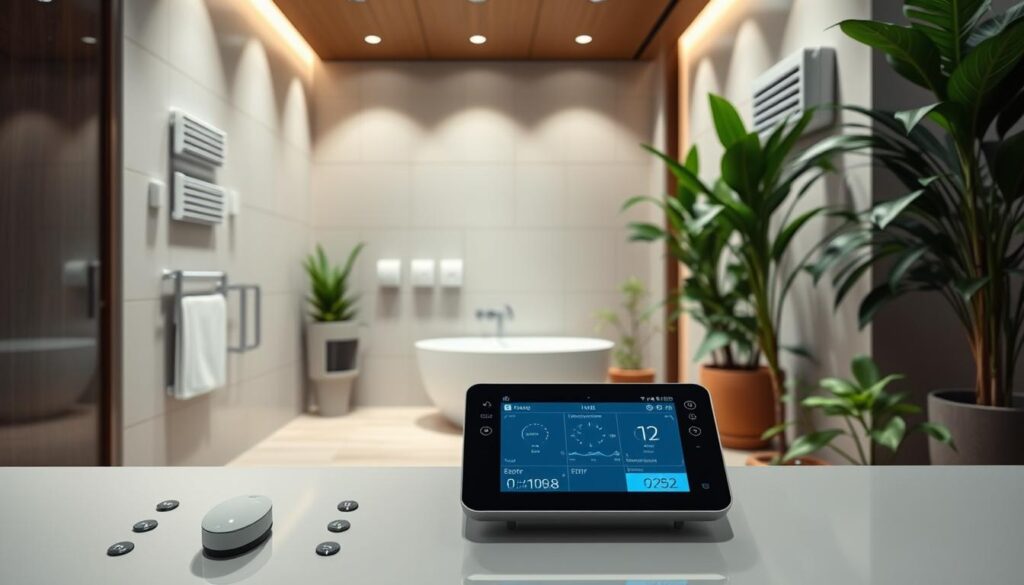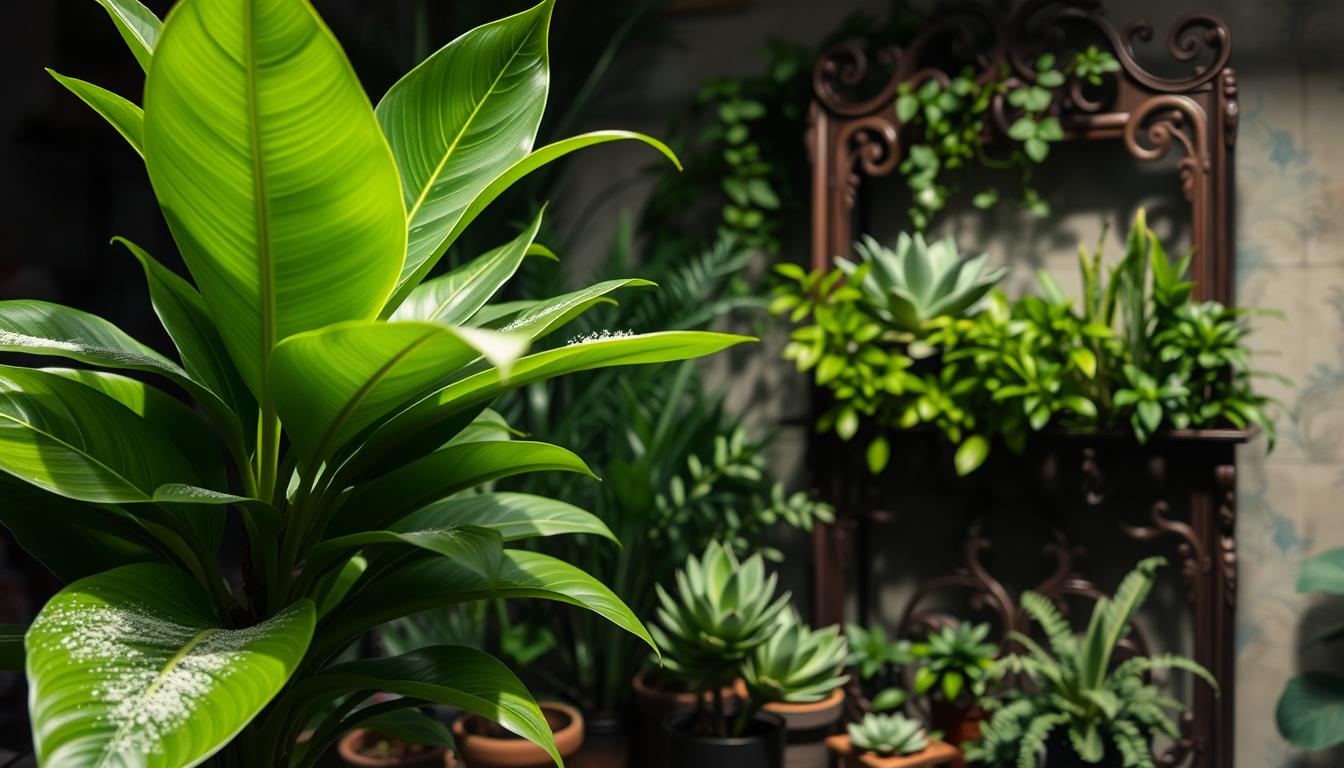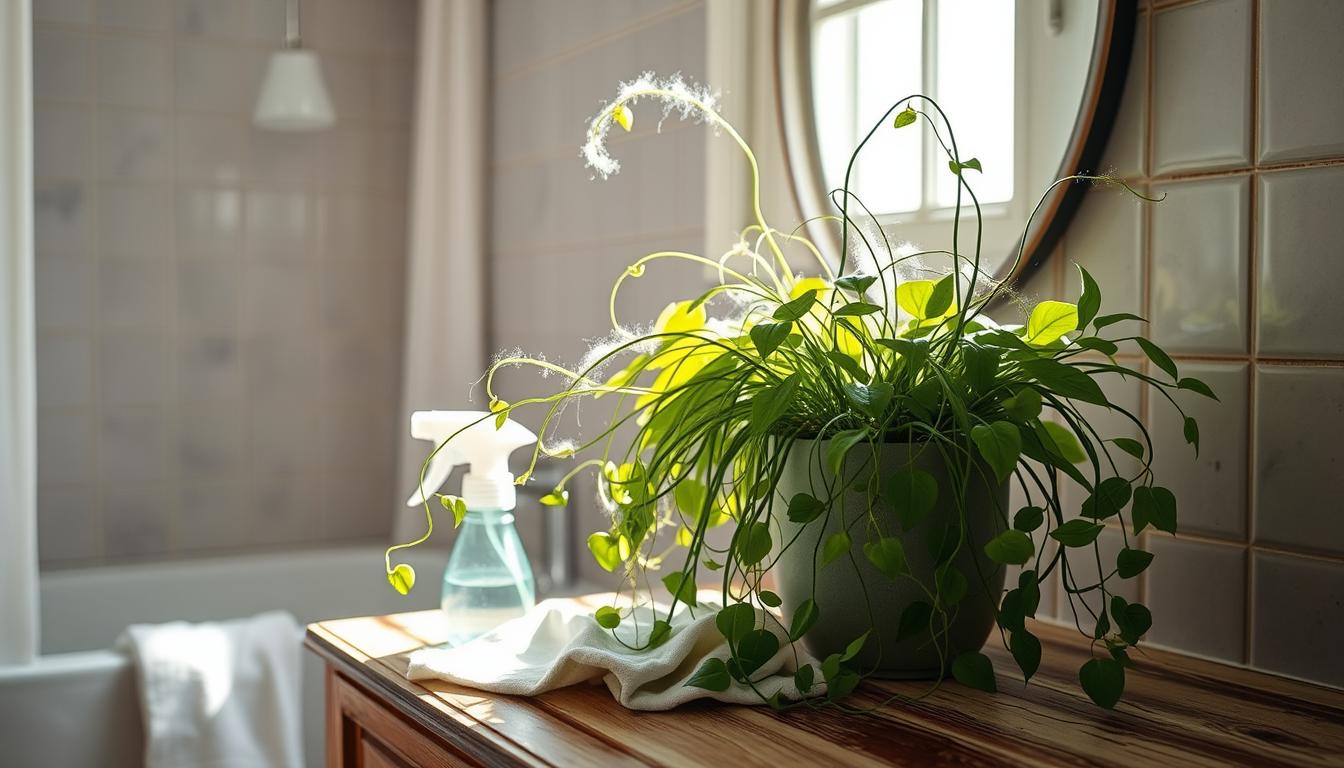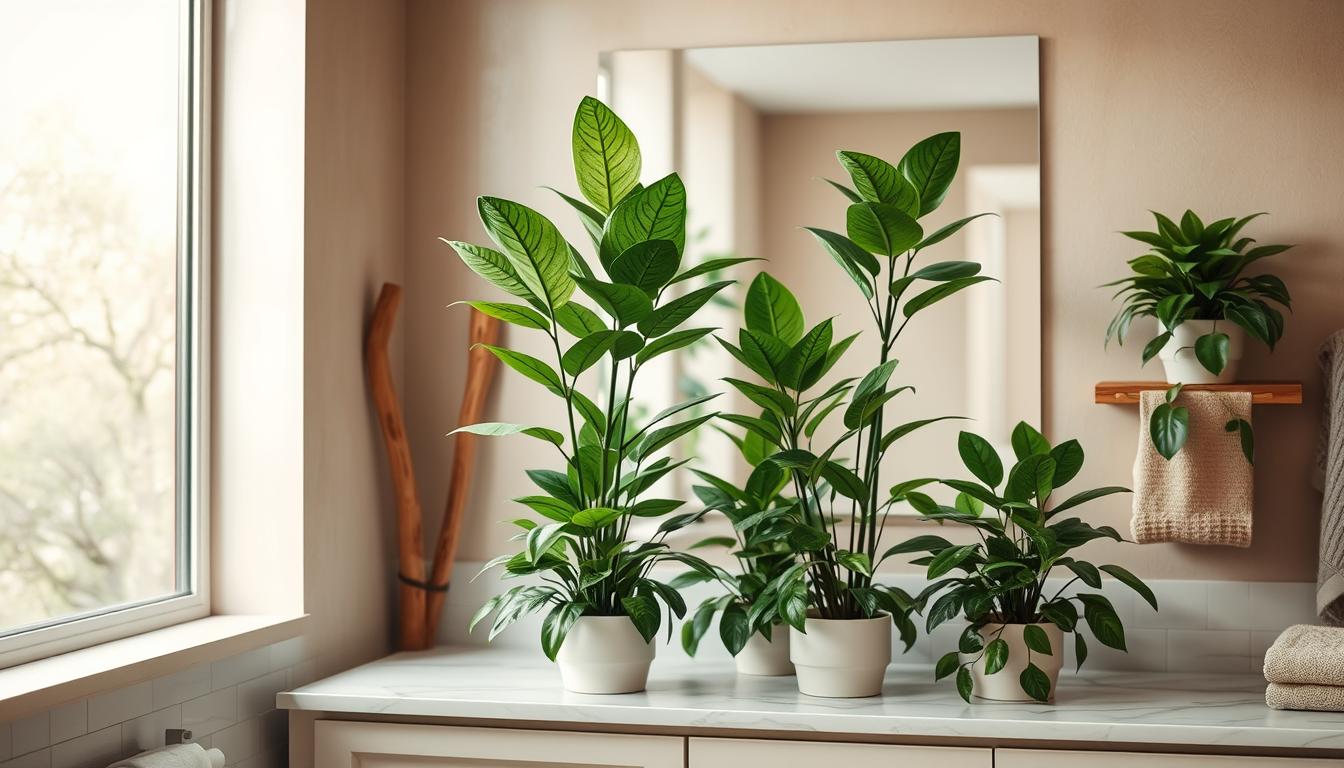In high-humidity bathrooms, artificial plants add beauty and function. But, they can also attract mold if not cared for. Knowing how to fight mold on these plants is key for a healthy home. This article will explore mold risks in bathrooms and how to prevent and clean mold on artificial plants. With this info, you can keep your space looking great and mold-free.
Understanding Mold and Its Risks
Mold is often found in households, especially in places with lots of moisture. It’s important to know about mold to keep your home healthy. This type of fungus grows in wet spots and produces spores. These spores can be bad for your health if you breathe them in. Knowing the different kinds of mold at home can help you spot health risks.
What is Mold?
Mold is made up of many fungi that grow in wet places. These organisms don’t have chlorophyll, so they feed on organic stuff. They love basements, bathrooms, and other wet areas. Mold spreads by sending out tiny spores into the air. These spores can be a risk to your health.
Common Types of Mold Found in Homes
There are several molds you might find inside your home, and each one is different. Some you might see include:
- Alternaria: This mold is common in wet places and can cause allergies.
- Aspergillus: There are many kinds of this mold. Some kinds can make toxins that are harmful.
- Penicillium: It often grows on wet materials in buildings and can make breathing problems worse.
Being around these molds can cause breathing problems, allergies, and worse asthma. This is especially true for kids and older people.
Why High Humidity Facilitates Mold Growth
High humidity makes indoor areas wet, which helps mold grow. Knowing why this happens, especially in bathrooms, helps us stop it.
Humidity and Mold Conditions
When indoor humidity goes over 40%, mold likes it and starts to grow. Things like showers, cooking, and bad ventilation make moisture go up. If air doesn’t move, moisture stays, letting mold grow.
How Bathroom Environments Promote Mold
Bathrooms get really wet from showers and baths. But often, there’s not enough air moving around. So, things like fake plants get moldy. Keeping air moving and humidity low stops mold in the bathroom.
Identifying Mold on Artificial Plants
Finding mold on fake plants is key to keeping your home safe, especially in moist places like bathrooms. Spotting the signs of mold on these plants can stop major mold problems and keep your indoor areas healthy.
Signs of Mold on Artificial Plants
It’s important to know what to look for when checking for mold. The signs include:
- Discoloration: Brown or black spots often show there’s mold.
- Musty Odor: A moldy smell means mold might be growing.
- Visible Growth: Mold can look fuzzy or have a web-like look on surfaces.
Watching for these signs helps you recognize mold early on.
Common Mistakes in Recognizing Mold
People often mix up mold with dust or dirt and don’t act quickly. Missing the early signs of mold on fake plants can cause a lot of mold problems later. It’s important to identify mold early to clean it up fast.
Combatting Mold on Artificial Plants in High-Humidity Bathroom Area
Artificial plants in humid bathrooms can develop mold. Cleaning them without causing damage is critical for their maintenance. Using the right approach will keep them looking good and ensure they’re clean and safe.
Effective Cleaning Solutions
For cleaning, think about using hydrogen peroxide or vinegar. These are safe for the plants and can kill mold. Stay away from strong chemicals. They could damage the artificial plants.
Step-by-Step Mold Removal Process
Follow these steps for an efficient mold removal process:
- Remove the artificial plants from the bathroom and take them to a well-ventilated area.
- Wipe down the surfaces of the plants with the chosen cleaning solution.
- Rinse the plants with clean water to remove any cleaning agent residue.
- Ensure the plants dry thoroughly to prevent any residual moisture that could encourage future mold growth.
- Place the clean, dry artificial plants back in the bathroom.
Preventative Measures Against Mold Growth
Taking steps early can really help stop mold on artificial plants. This is very important in places with a lot of humidity. Knowing how to keep the right humidity and how to take care of artificial plants is essential.
Maintaining Optimal Humidity Levels
Keeping humidity under 40% is key to stopping mold. Use exhaust fans when you shower and a bit after to remove moisture. A hygrometer is a good buy to keep an eye on humidity levels.
Best Practices for Caring for Artificial Plants
Keeping artificial plants clean is very important to prevent mold. Dust them regularly to stop mold from starting. Check your plants often for any signs of mold to catch it early. Making sure air flows well around them also helps reduce mold risk.
Cleaning Products for Mold Prevention
Choosing the right cleaning products is key to stopping mold growth on fake plants. This is especially true in damp areas like bathrooms. Effective mold cleaners greatly lower the chances of mold. Both commercial and homemade cleaners can help keep areas mold-free.
Recommended Cleaning Agents
Pick mold cleaners that are designed to fight mold but are still safe for your plants. These are some top choices:
- Products with EPA registration meet safety standards.
- Mild detergents with warm water are good for regular cleaning.
- Enzyme-based cleaners cut through mold without damaging your plants.
Homemade Cleaning Solutions
For a natural route, there are several effective DIY mold fighters. Try these:
- White vinegar is great at battling mold and is safe for most surfaces.
- A mix of bleach and water can be effective. Just make sure it’s safe for your material.
- Tea tree oil in water cleans and helps prevent mold.
Airflow and Ventilation in Bathrooms
Ensuring your bathroom has good airflow is key to keeping it mold-free. Proper ventilation cuts down humidity, stopping moisture from gathering on surfaces, like artificial plants. Knowing how airflow works helps keep mold at bay.
Importance of Proper Air Circulation
Air circulation matters a lot for stopping mold. Without fresh air, humidity goes up, surfaces stay wet, and mold is more likely. Keeping air moving in your bathroom is a must.
Tips for Improving Bathroom Ventilation
These simple actions can make your bathroom air better:
- Run exhaust fans for at least 30 minutes after showering.
- Keep bathroom doors slightly ajar to promote air circulation.
- Open windows periodically to allow fresh air into the space.
- Utilize a small fan within the bathroom for additional airflow.
Managing Humidity with Technology
Keeping the right humidity at home helps stop mold, especially in wet places like bathrooms. Using tech can improve how you control moisture. Knowing the best ways to do this makes your home’s air better.
Using Dehumidifiers Effectively
Dehumidifiers are key in removing air moisture. Using them often, especially in moist spots, helps keep humidity just right. Here’s how to get the most from your dehumidifier:
- Choose a dehumidifier that fits your room’s size.
- Set it to keep humidity under 40% to block mold.
- Make sure it’s placed for the best air flow.
- Clean the filter often to keep it working well.
Monitoring Humidity Levels
Keeping an eye on humidity is crucial for a healthy home. Hygrometers help you know the moisture level. Think about these tips for checking humidity:
- Put hygrometers where it gets moist, like in bathrooms and kitchens.
- Regularly check the numbers to spot any changes fast.
- Change dehumidifier settings based on what the hygrometer shows.
- Staying on top of this stops too much moisture and mold.

When to Seek Professional Help
Knowing when to call for professional mold help is key. Certain situations need expert help right away, especially when mold signs show a big problem.
Identifying Severe Mold Infestations
Be on the lookout for these serious mold signs:
- Frequent reappearance of mold after cleaning efforts.
- Extensive growth developing in multiple areas.
- Persistent musty odors throughout the space.
These signs mean the issue might be too much for DIY solutions. It’s time to get pros involved.
Benefits of Professional Mold Removal Services
Choosing mold removal pros brings many benefits:
- Access to specialized techniques and equipment that ensure thorough elimination of mold.
- Enhanced safety during the removal process, protecting you and your family from potential health risks associated with mold.
- Professional assessments that can identify hidden mold sources, preventing future infestations.
With expert help, homeowners can tackle mold issues effectively. This keeps their homes safe and sound.
Long-term Care for Artificial Plants
To keep your artificial plants looking great, they need proper care. Regular cleaning stops mold and keeps them looking new. Let’s look into how often you should clean and ways to keep mold away.
Cleaning Frequency Recommendations
For best results, clean your artificial plants monthly. This removes dust that can catch moisture, leading to mold. If your house is very humid, or the plants are in a moist area, clean them more often.
Avoiding Future Mold Infestations
To stop mold, put your artificial plants in areas with less humidity. Always dry them well before storing to prevent mold. Check your plants regularly for mold to deal with it early on.
Additional Tips for Mold Prevention
Keeping your home free from mold is an ongoing task. It requires a few easy steps. By doing regular upkeep, you can lower the risk of mold growth. This is especially true in damp places like bathrooms. Taking steps ahead of time means a healthier place to live.
Routine Maintenance Tips
To fight mold, it’s important to keep your bathroom clean. Here are some tips to help you out:
- Wipe down surfaces, including walls and fixtures, to prevent moisture accumulation.
- Use a shower squeegee after each use to minimize water left on surfaces.
- Check for leaks in plumbing fixtures and repair them promptly to reduce moisture levels.
- Regularly empty and clean any bathroom mats or rugs that may trap humidity.
Creating a Mold-Free Environment
For mold prevention, think about lighting and airflow. Follow these steps for a mold-free space:
- Ensure adequate ventilation by keeping windows open whenever possible.
- Use exhaust fans during and after showers to expel humid air.
- Keep areas well-lit to discourage mold growth, as darkness promotes dampness.
- Declutter spaces to enhance airflow, making it harder for moisture to settle.
Conclusion
The importance of managing mold in bathrooms can’t be ignored, especially with artificial plants. Mold in bathrooms can be a major health issue. It’s key to clean regularly and keep humidity low to stop mold from growing.
Knowing how mold grows helps people keep their homes and fake plants looking good. By cleaning your artificial plants often, they will stay bright and free of mold. This makes your bathroom look better.
To stop mold, follow the steps we’ve talked about. Keeping your home mold-free makes it a healthier place. Start now to keep your bathroom clean and free from mold. This way, you can enjoy your artificial plants without worrying about mold.



